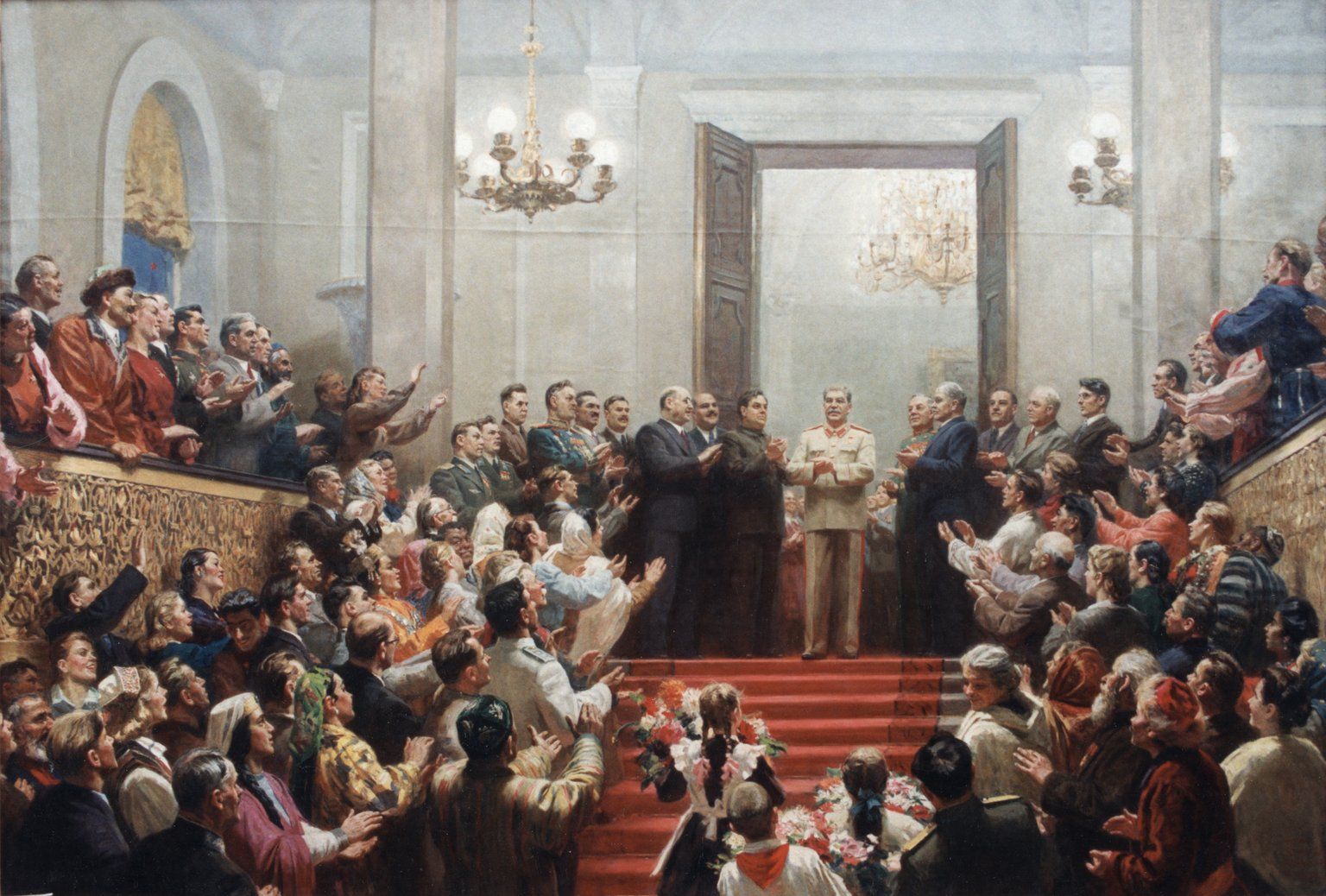Do dictators ever stand alone? A dictator is defined as a one who has total power over country, but is that even possible? Can one man ever have total control of a nation, even if he wields, say, Stalin’s iron fist?
When we think of Stalin’s USSR, we tend to imagine a totalitarian world that resembles Orwell’s 1984. At the head of the state is Stalin. Directly below him is a hierarchy of mindless henchmen. And of course, below them is the constantly terrorized multitude which is under constant watch by the regime. This narrative is a myth of history.
This narrative completely deprives anybody any agency besides Stalin. Like many myths of history, it is an oversimplification which meets a political agenda. The truth is far more complicated.
I am not doubting the brutality of the Stalinist Regime. The historiography on the Stalinist era is riddled with horrors (often down-played by contemporary leftists). There was the mass famine created during collectivization in the Ukraine that killed at least 3.3 million people.
Mass paranoia and accusations swept across the land in the Great Purges of the 1930s. After show trials in kangaroo courts, the accused would be evicted from their homes and exiled to Siberian Gulags, if lucky – and immediately shot, if not.
None of these horrors are in doubt. There is a lot of bloodshed and violence to be accounted for, but was it all done at the behest of one man alone?
There is a lot of bloodshed and violence to be accounted for, but was it all done at the behest of one man alone?
Stalinism went beyond Stalin. The historiography shows that large portion of the population was more than willing to participate in Stalinism. There is a lesson to be learned here, if we wish to fight the dictatorships of the present.
Collectivization was big task. Such economic reform was the push to get citizens of the USSR to nationalize their possessions, farmland, and estates into a single collective. Many Ukrainians refused to yield to be part of collective farms.
In fact, “activists” and others aided the state in the forced collectivization of the countryside.
Hundreds of devoted communists came down from the cities to terrorize the peasantry.
These “progressives” were aided by peasants who believed in the creation of the collective farms for political and personal gain. Those under Stalin acted on their own initiative in this very anarchic part of Ukrainian history.
Collectivization couldn’t have happened without the mass support of communists on the ground.
Where did these communist supporters, the communards, come from? Before Stalin even took power, there was a massive push by students to form collectives and inspire workers and peasants to do the same. The seeds of communism were grassroots before they blossomed into atrocities.
The Great Purge is another example of a Soviet catastrophe that transcends Stalin’s “total” power, fueled by an active engagement of the population.
Starting with Stalin eliminating right-wingers in his inner circle, the purge spirals off into a nationwide frenzy.
Colleague purged colleague, co-worker purged co-worker, and neighbour purged neighbour in a chaotic slew of accusations.
People on the ground had much to gain from participating in the witch-hunt, including wealth, power, and fame. Worst of all, many believed that purging those around them was an act of patriotism.
The blood of these victims is shared by the citizens of the USSR.
If we say that Stalin had all the power, then we deprive the accusers and activists of any agency. And if the accusers had no agency over their actions, then how can they share in the guilt of these heinous deeds?
If Stalin was a totalitarian (meaning that he wielded total power), then we deprive the citizenry of the Soviet Union any agency. The fact is, the Soviet citizenry hosted Stalinism, or at least participated in it.
How could they be guilt-free from the atrocities of the Stalinist regime? To believe so would be an injustice to victims of famine who died in collectivization, and the victims silenced and exiled by the purge.
Well then what is Stalin’s dictatorship? If it’s not total power, then what is it? Stalinism was the true enemy of the people, not Stalin himself. Dictatorship is the control of information. It is the
manipulation of minds though coercion and deceit. Dictatorship is a belief, not a person. Insomuch as people use force, they are believers in dictatorship. Insomuch as people pollute the air with their own dishonesty, they are believers in dictatorship. It’s not Stalin you have to worry about, it’s the Stalinists.
The historiography reveals a great sense of belief in Stalinism amongst the people. Diaries reveal how a great deal of their authors were “progressives” who were repulsed by “backwards” conservatives.
Sons of kulaks (nebulous term for farmers who were deemed unprogressive) would join the State in the witch-hunt against their own kinsmen, so that they could fit in to the new social order by doing away with the old.
The citizenry constantly engaged with the state to settle personal problems, from marriage advice to bad blood between friends (these were all former functions of the Russian Orthodox Church). Stalinism was, in fact, a secular theocracy, full of ardent believers.
There are some lessons to be learned from understanding the nature of dictatorship. When you hear about a dictator on the news, don’t assume that his people are all plotting against him. Shockingly, the opposite is more likely to be true. Also, most professors and students at universities aren’t against the dictatorship of their nation either, they’re just rebels without a clue.
Most importantly, when your neighbours start charging each other with meaningless accusations, know that a purge is knocking at the door. And if you survive the witch-hunts, console yourself with the knowledge that the madness can’t last forever, not if we take a stand.
We must continually counter tyranny, with the greater assertion of our freedom.
